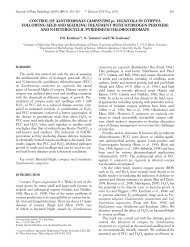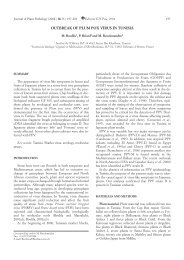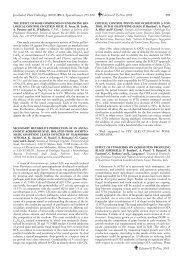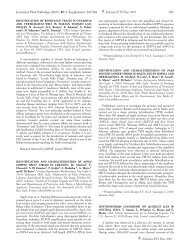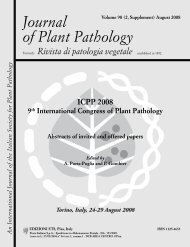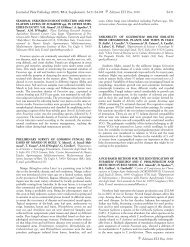Journal of Plant Pathology - Sipav.org
Journal of Plant Pathology - Sipav.org
Journal of Plant Pathology - Sipav.org
You also want an ePaper? Increase the reach of your titles
YUMPU automatically turns print PDFs into web optimized ePapers that Google loves.
S1.36 Effects <strong>of</strong> prohexadione-calcium on grape cluster structure <strong>Journal</strong> <strong>of</strong> <strong>Plant</strong> <strong>Pathology</strong> (2011), 93 (1, Supplement), S1.33-S1.37<br />
Fig. 5. B. cinerea disease severity in the four different variants<br />
(bars=standard errors; n=100).<br />
Fig. 6. Sugar concentration measured in KMW (Klosterneuburger<br />
Mostwaage). Values are mean ± standard error<br />
(n=100).<br />
DISCUSSION<br />
The field experiment showed that disease pressure<br />
strongly influences results. The health <strong>of</strong> the grapes is a<br />
primary goal <strong>of</strong> quality-oriented viticulture. B. cinerea is<br />
difficult to control because it has a variety <strong>of</strong> modes <strong>of</strong><br />
attack, diverse hosts as inoculum sources, and it can<br />
survive as mycelium or conidia. For these reasons, the<br />
use <strong>of</strong> any single control measure is unlikely to succeed<br />
(Williamson et al., 2007). B. cinerea infection is dependent<br />
on some kind <strong>of</strong> damage to the berry skin to provide<br />
a point <strong>of</strong> entry, for example parasite attack, hail damage<br />
and strong water absorption which can lead to rapid<br />
bursting <strong>of</strong> the berries or dislodged berries that are imprisoned<br />
inside the grape cluster. The thick cuticle <strong>of</strong><br />
the grape berry usually provides a mechanical barrier<br />
against B. cinerea infection (Ribéreau-Gayon et al.,<br />
2006). Another reason for B. cinerea infection can be<br />
grape compactness, which leads to burst berries. This<br />
depends on the variety, on whether there is a high number<br />
<strong>of</strong> remaining berries after blooming, but also on the<br />
size <strong>of</strong> individual berries (Kast, 2007).<br />
In 2008, prohexadione-calcium yielded less compact<br />
grapes, hence preventing B. cinerea.attacks. Thus, it improved<br />
quality and quantity <strong>of</strong> the yield without risk for<br />
consumers or the environment. As mentioned, prohexadione-calcium<br />
is a gibberellin biosynthesis inhibitor<br />
whose mode <strong>of</strong> action differs from that <strong>of</strong> other gibberellin<br />
biosynthesis inhibitors currently used in agriculture.<br />
Many <strong>of</strong> these growth regulators, including the<br />
quaternary ammonium compounds, substituted pyrimidines,<br />
norbornenodiazetine derivates, and triazole derivates<br />
(Graebe, 1987) function by interrupting the synthesis<br />
<strong>of</strong> gibberellin early in the biosynthetic pathway,<br />
specially at the synthesis <strong>of</strong> ent-kaurene. The use <strong>of</strong> another<br />
plant growth regulator (gibberellic acid) leads to<br />
the extension <strong>of</strong> the stems and blossom drop, which<br />
can lead to yield reduction and should be avoided. Longitudinal<br />
growth can be increased, although not without<br />
limits, since a genetically caused border exists<br />
(Spies and Hill, 2008). In this experiment, no changes<br />
could be observed in length growth following the use <strong>of</strong><br />
prohexadione-calcium. A correlation between berry<br />
weight and number <strong>of</strong> berries was found although the<br />
results showed that the treatment prohexadione-calcium<br />
resulted in many small berries with a diameter <strong>of</strong> 3<br />
mm, which generally reduces compactness. It was confirmed<br />
that the use <strong>of</strong> prohexadione-calcium leads tendentially<br />
to more berries with a diameter around 8-10<br />
mm as previously observed by Haas et al. (2009). However,<br />
in the present study, no significant difference was<br />
found in the induction <strong>of</strong> loose grape clusters and the<br />
subsequent infestation <strong>of</strong> B. cinerea. Prohexadione-calcium<br />
had minimal effects on pH or titratable acidity<br />
and on sugar content <strong>of</strong> musts in 2009, in agreement<br />
with Lo Giudice et al. (2004) who reported that an immediate<br />
postbloom application had no impact on soluble<br />
solids (Brix). In 2010, control bunches had a sugar<br />
concentration <strong>of</strong> 13.5 “Klosterneuburger Mostwaage”<br />
(KMW) whereas a higher sugar content was observed<br />
in the treatment prohexadione-calcium with 14.3<br />
KMW.<br />
In conclusion, the data presented here show that the<br />
result <strong>of</strong> the application <strong>of</strong> a plant growth regulator depends<br />
on different environmental parameters, among<br />
which the exact timing <strong>of</strong> application during flowering,<br />
the rainfall and the pathogen’s infestation pressure.



